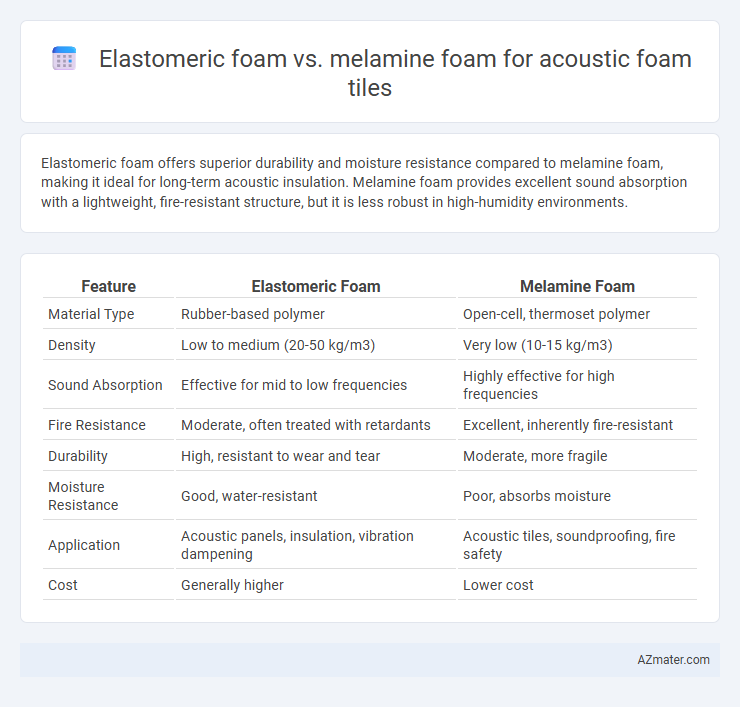Elastomeric foam offers superior durability and moisture resistance compared to melamine foam, making it ideal for long-term acoustic insulation. Melamine foam provides excellent sound absorption with a lightweight, fire-resistant structure, but it is less robust in high-humidity environments.
Table of Comparison
| Feature | Elastomeric Foam | Melamine Foam |
|---|---|---|
| Material Type | Rubber-based polymer | Open-cell, thermoset polymer |
| Density | Low to medium (20-50 kg/m3) | Very low (10-15 kg/m3) |
| Sound Absorption | Effective for mid to low frequencies | Highly effective for high frequencies |
| Fire Resistance | Moderate, often treated with retardants | Excellent, inherently fire-resistant |
| Durability | High, resistant to wear and tear | Moderate, more fragile |
| Moisture Resistance | Good, water-resistant | Poor, absorbs moisture |
| Application | Acoustic panels, insulation, vibration dampening | Acoustic tiles, soundproofing, fire safety |
| Cost | Generally higher | Lower cost |
Introduction to Acoustic Foam Tiles
Acoustic foam tiles are designed to absorb sound waves, reducing noise and improving room acoustics. Elastomeric foam offers high durability and effective low-frequency absorption, making it ideal for soundproofing studios and industrial spaces. Melamine foam features a lightweight, open-cell structure, delivering excellent high-frequency absorption while resisting fire and chemical damage.
What is Elastomeric Foam?
Elastomeric foam is a flexible, closed-cell polymer material known for its excellent sound absorption and thermal insulation properties, making it ideal for acoustic foam tiles. Unlike melamine foam, which is rigid and open-celled, elastomeric foam provides superior durability and resistance to moisture, chemicals, and compression. Its ability to reduce noise by dampening sound waves and vibrations makes it a preferred choice for environments requiring effective sound control and long-lasting acoustic solutions.
What is Melamine Foam?
Melamine foam is a lightweight, open-cell polymer primarily used for acoustic foam tiles due to its excellent sound absorption capabilities and fire-resistant properties. Unlike elastomeric foam, which is denser and more flexible, melamine foam has a rigid structure that traps sound waves effectively while being resistant to heat and chemicals. Its unique microstructure makes melamine foam ideal for reducing echo and controlling noise in environments such as recording studios, offices, and industrial settings.
Sound Absorption Performance Comparison
Elastomeric foam offers superior low-frequency sound absorption, making it ideal for environments needing effective bass reduction, while melamine foam excels at absorbing mid to high-frequency noise due to its open-cell, rigid structure. The Sound Absorption Coefficient (NRC) of elastomeric foam typically ranges from 0.6 to 0.9 across 125 Hz to 4000 Hz, whereas melamine foam demonstrates an NRC between 0.7 and 0.95, particularly efficient above 1000 Hz. Selecting between these foams depends on specific acoustic requirements, with elastomeric foam preferred for broader spectrum noise control and melamine foam favored for specialized high-frequency sound treatment.
Fire Resistance and Safety Standards
Elastomeric foam offers superior fire resistance compared to melamine foam, with a higher ignition temperature and lower smoke emission, making it compliant with stringent fire safety standards such as ASTM E84 Class A. Melamine foam, while lightweight and effective for sound absorption, tends to have lower fire resistance and can produce toxic gases when burned, limiting its use in environments with strict fire codes. Choosing elastomeric foam for acoustic foam tiles enhances safety by meeting rigorous fire safety regulations and minimizing fire-related hazards.
Durability and Longevity
Elastomeric foam offers superior durability and longevity compared to melamine foam due to its closed-cell structure, which resists moisture, wear, and compression over time. Melamine foam, while excellent for high-frequency sound absorption, tends to be more fragile and prone to crumbling or degradation under prolonged impact or environmental stress. For acoustic foam tiles in environments requiring long-term performance, elastomeric foam is the preferred choice for maintaining structural integrity and acoustic efficacy.
Installation Processes and Ease
Elastomeric foam acoustic tiles offer straightforward installation with flexible adhesives and simple cutting tools, making them ideal for irregular surfaces and quick fitting. Melamine foam tiles, while lightweight and fire-resistant, require careful handling due to their brittle nature and are often mounted using spray adhesive or mechanical fasteners to avoid damage. Both materials provide effective sound absorption, but elastomeric foam generally allows easier modification and repositioning during installation.
Cost Comparison: Elastomeric vs Melamine
Elastomeric foam acoustic tiles generally cost more than melamine foam due to their superior durability and resistance to wear, making them a long-term investment for sound absorption. Melamine foam offers a budget-friendly option with lower upfront costs, though it tends to degrade faster in high-traffic or humid environments. Choosing between elastomeric and melamine foam depends on balancing initial expenditure against lifespan and performance in specific acoustic treatments.
Environmental Impact and Sustainability
Elastomeric foam, often made from synthetic rubber like neoprene or EPDM, has a longer lifespan and offers better durability but relies on petroleum-based materials, resulting in higher carbon emissions during production. Melamine foam, derived from thermosetting polymers, is lighter and biodegradable under certain conditions, making it more environmentally friendly and easier to recycle compared to conventional elastomeric foam. Sustainable acoustic foam tiles increasingly favor melamine foam for its lower environmental footprint and potential for reduced waste in green building projects.
Choosing the Right Acoustic Foam for Your Needs
Elastomeric foam offers superior durability and enhanced sound absorption across a broader frequency range, making it ideal for high-traffic environments and professional studios. Melamine foam is lightweight, fire-retardant, and excels at reducing mid to high-frequency noise, suitable for residential or office spaces requiring budget-friendly acoustic treatment. Selecting between elastomeric and melamine foam depends on the specific acoustic performance, fire safety requirements, and installation environment.

Infographic: Elastomeric foam vs Melamine foam for Acoustic foam tile
 azmater.com
azmater.com